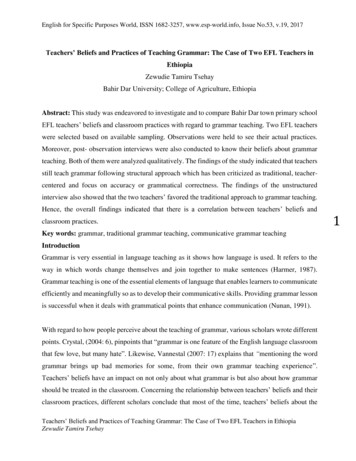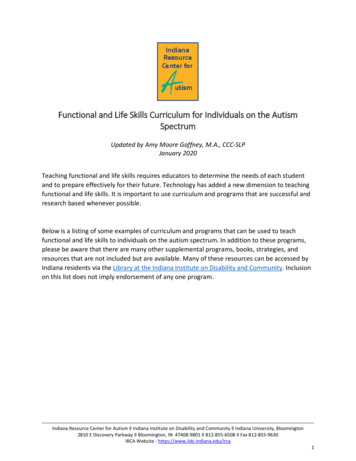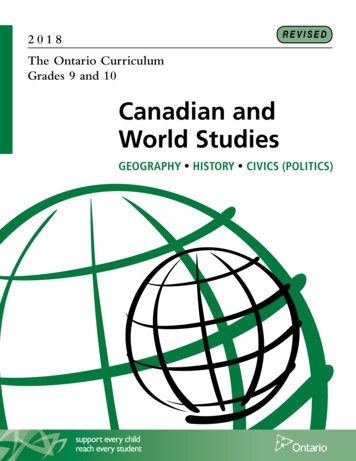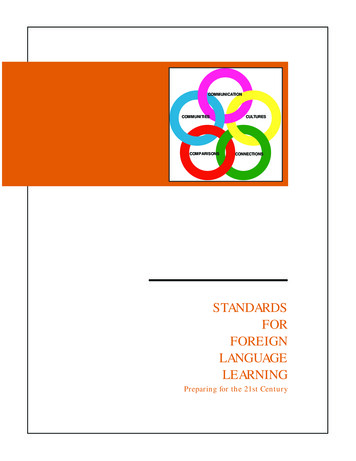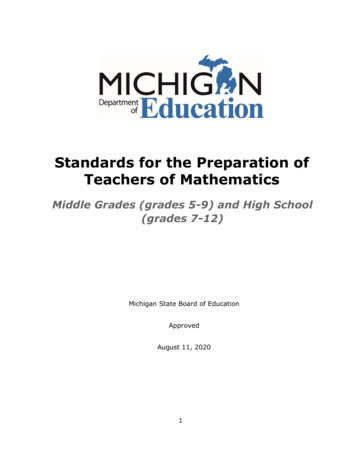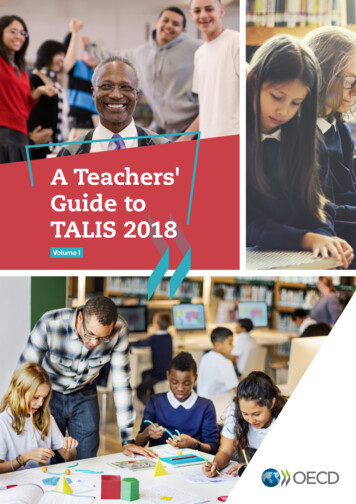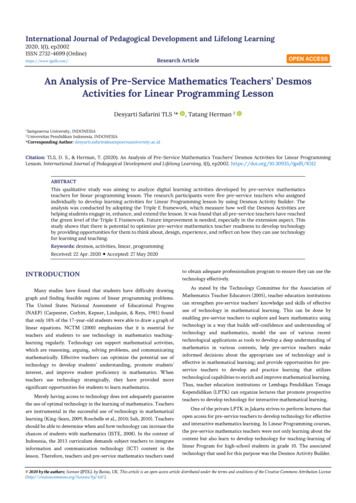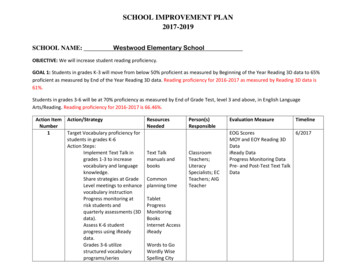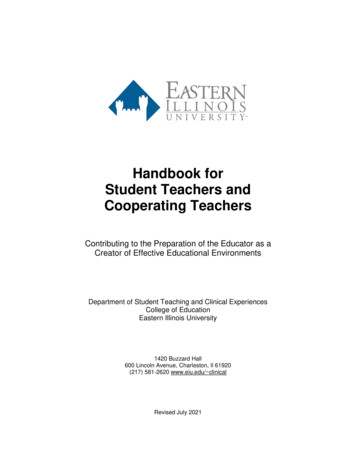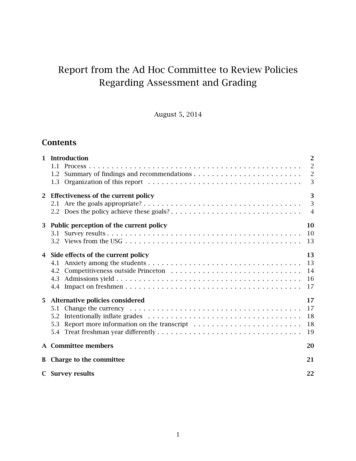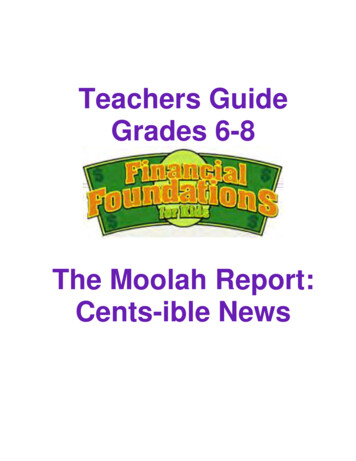
Transcription
Teachers GuideGrades 6-8The Moolah Report:Cents-ible News
“The Moolah Report”: Cents-ible NewsFinancial Foundations for All Kidswww.financialfoundationsforkids.comCopyright 2005 KCEE. All Rights ReservedTable of ContentsGrade 6: Program 1 – The Budget Balancing ActEpisode 1 – Budgeting, Trade-offs, and Opportunity CostsEpisode 2 – Spending Less, Saving the RestEpisode 3 – Income Management and Payment MethodsEpisode 4 – To Spend, Save, or Borrow? That is the Question!Grade 6: Program 2 – The Specs on SpecializationEpisode 1 – The Importance of SpecializationEpisode 2 – The Effect of Productivity on IncomeEpisode 3 – Improving Productivity through SpecializationGrade 7: Program 1 – Personal and Public BenefitsEpisode 1 – Inflation and DeflationEpisode 2 – Positive and Negative IncentivesEpisode 3 – Types of Employee BenefitsEpisode 4 – Government Goods and ServicesGrade 7: Program 2 – Investing in Your FutureEpisode 1 – Human Capital Supply and DemandEpisode 2 – What is Compound Interest?Episode 3 – Return, Liquidity, and RiskEpisode 4 – Costs and Benefits of Spending, Saving, or BorrowingGrade 8: Program 1 – Income, Incentives, andInstitutionsEpisode 1 – Types of Earned IncomeEpisode 2 – Employee Responses to Positive and Negative IncentivesEpisode 3 – Specialized Economic InstitutionsGrade 8: Program 2 – Starting the Savings SnowballEpisode 1 – Saving Accumulation: Amount Saved, Rate of Return, and TimeEpisode 2 – Products and Services: Spending, Saving, and Borrowing DecisionsEpisode 3 – Calculating Interest and Account BalancesGrade 8: Program 3 – Mastering Your MoneyEpisode 1 – Opportunity Cost: Decisions for Your BudgetEpisode 2 – Being an Informed ConsumerCodes: S Standard; B Benchmark; K Knowledge Indicator2
“The Moolah Report”: Cents-ible NewsFinancial Foundations for All Kidswww.financialfoundationsforkids.comCopyright 2005 KCEE. All Rights ReservedLearning StandardsNational Economics StandardsNational Personal Finance StandardsMath StandardsCommunication Arts StandardsCORRELATIONS: Economics/Personal Finance/Math/Language ArtsGLOSSARYCodes: S Standard; B Benchmark; K Knowledge Indicator3
“The Moolah Report”: Cents-ible NewsFinancial Foundations for All Kidswww.financialfoundationsforkids.comCopyright 2005 KCEE. All Rights ReservedGrade 6: Program 1 – The Budget Balancing ActEpisode 1 – Budgeting, Trade-offs, and Opportunity Costs06 01 01Synopsis: The kids are delivering a news report on trade-offs and opportunity cost.Sloane is interviewing Jeremy regarding his decision to save part of his income for amountain bike, even though he would really like to spend it on an electric guitar. Theydetermine that the guitar is Jeremy’s opportunity cost.Interactive Exercises: Students define trade-offs and identify the opportunity cost of adecision.Standards/Concepts:Economics:S1 B3 Grade 8Social Studies:nonePersonal Finance:Mathematics:opportunity cost, trade-offssaving, financial decision making, budgetingequations, problem solvingLearning Objective: Students will explain that budgeting requires trade-offs inmanaging income and spending, and identify the opportunity costs that result fromthese trade-offsTime Required: 70 minutes (25 minutes for the computer program and 45 minutes for theactivity)Activity: Use “The Mint” lesson, Scarcity, Choice and Decisions, found online at:http://www.themint.org/teachers/scarcity.php. In this lesson, students are faced with scarcityin planning a prom and, then, in planning a budget. They must face trade-offs as theymake their choices.Glossary:BudgetTrade-offOpportunity tSavingMoneyTeacher Notes:Codes: S Standard; B Benchmark; K Knowledge Indicator4
“The Moolah Report”: Cents-ible NewsFinancial Foundations for All Kidswww.financialfoundationsforkids.comCopyright 2005 KCEE. All Rights ReservedGrade 6: Program 1 – The Budget Balancing ActEpisode 2 – Spending Less, Saving the Rest06 01 02Synopsis: Sloane interviews Polly regarding Polly’s spending and saving decisions. Polly wantsto go on a ski trip, but must pay for part of the expenses. She has no money for the trip, butcontinues to buy things she wants with her babysitting income and allowance. Sloane tries toexplain the concept of saving to Polly.Interactive Exercises: Students state that financial well-being can be gained by spending lessthan you earn and saving the difference. They identify ways they could buy some things they wantand save the rest.Standards/Concepts:Economics:S11 B1 Grade 8Social Studies:nonePersonal Finance:Mathematics:spending, saving, incomesaving, financial decision makingnumber senseLearning Objective: Students will state that a key to financial well-being is to spend less thanyou earn and save the difference.Time Required: 65 minutes (25 for the computer program and 40 minutes for the activity)Activity: A Penny Saved is a Penny at 4.7% Earned There are lots of ways to receive income,and lots of ways to spend it. In this lesson you will develop two budgets, or plans, to help youdecide how to allocate your income. Assuming you do not love making dollar bill lesson EM157&page rade-offOpportunity costTeacher Notes:Codes: S Standard; B Benchmark; K Knowledge Indicator5
“The Moolah Report”: Cents-ible NewsFinancial Foundations for All Kidswww.financialfoundationsforkids.comCopyright 2005 KCEE. All Rights ReservedGrade 6: Program 1 – The Budget Balancing ActEpisode 3 – Income Management and Payment Methods06 01 03Synopsis: Sloane interviews a banker about different methods of payment. Then, Seymour goeson to instruct on the maintenance of a checking account.Interactive Exercises: Students identify the function of a debit card and describe checkingaccount al Studies:nonePersonal Finance:Mathematics:costs, benefitspayment methods, consumer creditnumber sense, computationLearning Objective: Students will explain the basic financial tasks people use to manageincome. Students will explain why some payment methods cost more than others.Time Required: 25 minutes for the computer programActivity: Ask the students to discuss the differences between using a checking account and adebit card. Use the Checking Account Instructions and Forms to practice writing checks andbalancing the check ServicesTeacher Notes:Codes: S Standard; B Benchmark; K Knowledge Indicator6
“The Moolah Report”: Cents-ible NewsFinancial Foundations for All Kidswww.financialfoundationsforkids.comCopyright 2005 KCEE. All Rights ReservedGrade 6: Program 1 – The Budget Balancing ActEpisode 4 – To Spend, Save, or Borrow? That is the Question!06 01 04Synopsis: Seymour and Sloane debate the costs and benefits of spending, saving or borrowingdecisions.Interactive Exercises: Students define cost, benefit, spending, and saving and identify thecosts and benefits of spending, saving and borrowing.Standards/Concepts:Economics:S11 B1 Grade 8Social Studies:nonePersonal Finance:S3 B1 8th Grade K3,S3 B4 8th Grade K5Mathematics:spending, saving, costs and benefitsspending, consumer credit, borrowing, financialdecision makingnumber sense, problem solvingLearning Objective: Students will determine the costs and benefits of a spending, saving, orborrowing decision.Time Required: 65 minutes (25 minutes for the computer program and 40 minutes for theactivity)Activity: Use Climbing the Savings Mountain, an online lesson from the NCEE found on EM515&page teacher. In this lesson,students learn about different saving ingPriceMoneyGoodsServicesChoiceOpportunity costBankWantInterestTeacher Notes:Codes: S Standard; B Benchmark; K Knowledge Indicator7
“The Moolah Report”: Cents-ible NewsFinancial Foundations for All Kidswww.financialfoundationsforkids.comCopyright 2005 KCEE. All Rights ReservedGrade 6: Program 2 – The Specs on SpecializationEpisode 1 – The Importance of Specialization06 02 01Synopsis: Sloane interviews Wes Wiseman, the Theatre and Drama teacher at her school. Mr.Wiseman explains that by specializing in teaching theatre and drama, he is a better teacher than ifhe taught all subjects.Interactive Exercises: Students define specialization and match professions with the good orservice providedStandards/Concepts:Economics: S6 B1 Grade 4Social Studies:S7 K5 Grade 6-8Economics:5th Grade B1 K3 & K4Mathematics:specialization, human resources:geometric concepts, problem solvingLearning Objective: Students will identify careers that require specialized skills and discusswhy specialization is desirable.Time Required: 70 minutes (25 minutes for the computer program and 45 minutes for theactivity)Activity: Use the NCEE lesson, Frontier Specialists, found online on EM57&page teacher. In this lesson, studentsdiscover that the level of output in an economy can be increased through ervicesProductionProducerConsumerWantsTeacher Notes:Codes: S Standard; B Benchmark; K Knowledge Indicator8
“The Moolah Report”: Cents-ible NewsFinancial Foundations for All Kidswww.financialfoundationsforkids.comCopyright 2005 KCEE. All Rights ReservedGrade 6: Program 2 – The Specs on SpecializationEpisode 2 – The Effect of Productivity on Income06 02 02Synopsis: Sloane, who is investigating the link between worker productivity and income,interviews Marty McLoan. As chief foreman at Zoom, Inc., McLoan is aware of efforts the companymakes to help its employees become more productive.Interactive Exercises: Students identify which employee is likely to get a raise based on theemployees’ productivity.Standards/Concepts:Economics:Social Studies: nonePersonal Finance:Mathematics:S13 B4 Grade 8productivity, income, specializationS1 B2 8th Grade K5income, careerspattern recognition, problem solvingLearning Objective: Students will explain why increases in a worker’s productivity can result inhigher income.Time Required: 90 minutes (25 for the computer program and 65 minutes for the activity)Activity: WIDGET PRODUCTION: Producing More, Using Less In the first part of the lessonstudents take a quiz to review the major concepts taught in Lesson 7, "Widget Production," fromMaster Curriculum Guide in Economics: Teaching Strategies 5-6. Students then search the web forexamples of the many ways in which productivity has been increased over the years. Finally, theyidentify a situation where an increase in productivity could alleviate a problem and create a way tosolve this problem. They also analyze the costs and benefits of implementing their cfm?lesson EM539&page tProfitProducerConsumerCapital resourcesHuman resourcesNatural nPositive incentiveNegative incentiveTeacher Notes:Codes: S Standard; B Benchmark; K Knowledge Indicator9
“The Moolah Report”: Cents-ible NewsFinancial Foundations for All Kidswww.financialfoundationsforkids.comCopyright 2005 KCEE. All Rights ReservedGrade 6: Program 2 – The Specs on SpecializationEpisode 3 – Improving Productivity Through Specialization06 02 03Synopsis: Sloane interviews Kip Kipling, a high school student who has moved through severalemployment positions at the golf course. Sloane explains how Kip’s increase in human capitalmade him more productive and, therefore, more attractive to his employer.Interactive Exercises: Students identify actions that someone can take to increase humancapital, as well as identify how the supply and demand for people with certain skill levels caninfluence income.Standards/Concepts:Economics:Social Studies:Personal Finance:Mathematics:S15 B1 Grade 4S7 K5 Grade 6-8S1 B2 4th Grade K3human capital, productivityincome, human capitalalgebraic equationsLearning Objective: Students will give examples of how workers can improve their productivityby gaining new knowledge, skills, and experiences through specialization. Students will analyzehow supply of and demand for workers in various careers affect income.Time Required: 70 minutes (25 minutes for the computer program and 45 for the activity)Activity: Use the NCEE online lesson, Human Capital for Money, found on EM231&page teacherIn this lesson, students look at various careers and the human capital ProductivityHuman capitalWages/salaryPriceMoneyTeacher Notes:Codes: S Standard; B Benchmark; K Knowledge Indicator10
“The Moolah Report”: Cents-ible NewsFinancial Foundations for All Kidswww.financialfoundationsforkids.comCopyright 2005 KCEE. All Rights ReservedGrade 7: Program 1 – Personal and Public BenefitsEpisode 1 – Inflation and Deflation07 01 01Synopsis: Seymour explains how inflation is measured. Later, Sloane interviews an architectabout how a concern about prospective inflation affects contract negotiations for long-term architectservices, as well as how inflation concerns affects the method in which the architect saves.Interactive Exercises: Given a circumstance where prices increased from one year to thenext, students determine whether there has been an increase or decrease in purchasing power.They apply their knowledge of inflation to determine whether the return they would get from variousfinancial instruments would be sufficient to maintain their purchasing power.Standards/Concepts:Economics:Social Studies:Personal Finance:Mathematics:S19 B1 Grade 4;inflation, deflationS19 B3, S 19 B4 Grade 8noneS4 B5 8th Grade K5 inflation, purchasing power, deflation,spending and investing decisionscomputation, problem solvingLearning Objective: Students will explain the impact of inflation or deflation on the value ofmoney and people’s purchasing power.Time Required: 75 minutes (25 minutes for the computer program and 45 minutes for theactivity)Activity: One is Silver and the Other's Gold Students learn about the money supply and that itcan affect the value of money. Students investigate this in the 1896 presidential election (Bryan vs.McKinley, Free Silver vs. Gold Standard) and examine a political cartoon that depicts how somepeople felt about this issue. Students answer questions about what they would do with more moneyand what might happen if the money supply cfm?lesson EM395&page /salaryGoodsServicesCPISavingFinancial investmentRiskBenefitTeacher Notes:Codes: S Standard; B Benchmark; K Knowledge Indicator11
“The Moolah Report”: Cents-ible NewsFinancial Foundations for All Kidswww.financialfoundationsforkids.comCopyright 2005 KCEE. All Rights ReservedCodes: S Standard; B Benchmark; K Knowledge Indicator12
“The Moolah Report”: Cents-ible NewsFinancial Foundations for All Kidswww.financialfoundationsforkids.comCopyright 2005 KCEE. All Rights ReservedGrade 7: Program 1 – Personal and Public BenefitsEpisode 2 – Positive and Negative Incentives07 01 02Synopsis: Sloane interviews Polly’s sister Patience about the great deal on popular T-shirts goingon at Trendy World. Sloane refers to the “Buy 2, Get 1 Free” offer as a positive incentive thatcustomers respond to in pursuing their self-interest. Seymour continues the report by discussinghow people respond to negative incentives.Interactive Exercises: Students identify the positive incentive in an offer, as well as identifypositive incentives that are monetary and non-monetary.Standards/Concepts:Economics:S4 B1, S4 B3 Grade 8Social Studies:nonePersonal Finance:S3 B1 8th Grade K2Mathematics:self-interest, positive and negative incentivesspending decisionsnumber sense, computation, equationsLearning Objective: Students will explain how positive and negative incentives affect the waypeople behave. Students will recognize that responses to incentives are predictable becausepeople usually pursue their self-interest.Time Required: 65 minutes (25 minutes for the computer program and 40 minutes for theactivity)Activity: Use the NCEE online lesson, The Best Deal, found on EM530&page teacher. In this lesson,students learn how to determine the “price per unit” when comparing products.Glossary:Positive incentiveNegative er Notes:Codes: S Standard; B Benchmark; K Knowledge Indicator13
“The Moolah Report”: Cents-ible NewsFinancial Foundations for All Kidswww.financialfoundationsforkids.comCopyright 2005 KCEE. All Rights ReservedGrade 7: Program 1 – Personal and Public BenefitsEpisode 3 – Types of Employee Benefits07 01 03Synopsis: Seymour reports on the various types of employee benefits. In a later interview,Sloane interviews Buck Bargain, owner of Bargain Building, to see how offering benefits toemployees actually benefits the employer too.Interactive Exercises: Students identify different types of employee benefits and state thatemployee benefits can help to increase employee productivity.Standards/Concepts:Economics:S4 B1 Grade 8Social Studies:nonePersonal Finance:S1 B3 4th Grade K4Mathematics:employee benefits, wages and salariesemployee benefits, disposable incomealgebraic equations, problem solvingLearning Objective: Students will give examples of employee benefits that workers mayreceive in addition to their pay.Time Required: 45 minutes (25 minutes for the computer program and 20 minutes for theactivity, add 30-45 minutes for the report from students)Activity: Have students brainstorm questions they could ask adults about the employee benefitsthey receive from their employer and how the offering of these benefits affects the employees’productivity. Later, have each student conduct an interview of an adult with which he or she isfamiliar and report the results to the class.Glossary:Wages/salaryEmployee benefitsMoneyIncomePositive incentiveNegative incentiveProductivityTeacher Notes:Codes: S Standard; B Benchmark; K Knowledge Indicator14
“The Moolah Report”: Cents-ible NewsFinancial Foundations for All Kidswww.financialfoundationsforkids.comCopyright 2005 KCEE. All Rights ReservedGrade 7: Program 1 – Personal and Public BenefitsEpisode 4 – Government Goods and Services07 01 04Synopsis: Seymour explains the difference between public goods and private goods, and why itis necessary for governments to provide certain goods to their citizens.Interactive Exercises: Students identify the characteristics of a public good, and then choosethe public goods from a list of various goods, both public and private.Standards/Concepts:Economics:S16 B1Grade 4Social Studies:S7 K1, K3 Grade 6-8Personal Finance:S1 B3 8th Grade K4Mathematics:Comm. Arts:public goods and services, free ridergovernment transfer payments, incomestatistics, problem solvingvocabularyLearning Objective: Students will give examples of identify goods and services provided bylocal, state, and national governments.Time Required: 75 minutes (25 minutes for the computer program and 50 for the activity)Activity: Use the NCEE EconomicsInternational lesson, Public Goods and Services, foundonline at http://ncee.net/ei/lessons/OldMac/lesson6/. In this lesson, students compare and defineprivate and public goods. They receive money and must make a decision about paying for theheating in the classroom. This activity reinforces the concept of public goods and helps studentsidentify and explain the free-rider problem.Glossary:Public (government) goods & servicesNon-exclusionProfitTaxesTeacher Notes:Codes: S Standard; B Benchmark; K Knowledge Indicator15
“The Moolah Report”: Cents-ible NewsFinancial Foundations for All Kidswww.financialfoundationsforkids.comCopyright 2005 KCEE. All Rights ReservedGrade 7: Program 2 – Investing in Your FutureEpisode 1 – Human Capital Supply and Demand07 02 01Synopsis: Seymour discusses how human capital development can help people gain skills thatwill make them valuable in the labor market.Interactive Exercises: Students define human capital, and identify factors that affect anindividual’s income.Standards/Concepts:Economics:S13 B5 Grade 8Social Studies:Personal Finance:Mathematics:S7 K2 Grade 6-8S1 B2 8th Grade K17th Grade S1 B1, S2 B3 K1, K2human capital, income,demand and supply of laborcareers, incomecomputation, graphingLearning Objective: Students will explain how an individual’s income will differ in the labormarket depending on supply of and demand for his/her human capital.Time Required: 60 minutes (25 minutes for the computer program and 35 minutes for theactivity)Activity: Use the NCEE lesson, It Pays to Stay in School, found online on EM349&page teacher. In this lesson,students look at the private and public benefits of a well-educated society as well as the earningpotential associated with levels of education.Glossary:IncomeMarketSupplyDemandHuman capitalChoiceWageTeacher Notes:Codes: S Standard; B Benchmark; K Knowledge Indicator16
“The Moolah Report”: Cents-ible NewsFinancial Foundations for All Kidswww.financialfoundationsforkids.comCopyright 2005 KCEE. All Rights ReservedGrade 7: Program 2 – Investing in Your FutureEpisode 2 – What is Compound Interest?07 02 02Synopsis: Seymour demonstrates calculating compound interest, and then Sydney Goodcents(from the 3-5 programs) is interviewed by Sloane as they examine Polly’s bank statement.Interactive Exercises: Students define compound interest, and identify the factors thatdetermine the interest earned on savings – time, amount and interest rate.Standards/Concepts:Economics:S12 B1 Grade 12Social Studies:nonePersonal Finance:S4 B5 8th Grade K4Mathematics:interest, principal, compound interestsaving, financial decision makingequations, estimationLearning Objective: Students will explain that compound interest is interest earned on bothprincipal and previously earned interest. The interest earned depends on time, interest rate, and theamount saved.Time Required: 65 minutes (25 minutes for the computer program and 35 minutes for theactivity)Activity: Use a lesson based on the children’s book, The Hundred Penny Box, found on theWisepockets site athttp://www.umsl.edu/ l. In this lesson,students work through an exercise on compound interest.Glossary:Savings & Loan r Notes:Codes: S Standard; B Benchmark; K Knowledge Indicator17
“The Moolah Report”: Cents-ible NewsFinancial Foundations for All Kidswww.financialfoundationsforkids.comCopyright 2005 KCEE. All Rights ReservedGrade 7: Program 2 – Investing in Your FutureEpisode 3 – Return, Liquidity, and Risk07 02 03Synopsis: Sloane holds a panel discussion on the risk associated with various types of financialinvestments. She investigates instruments such as Certificates of Deposit, government bonds,corporate bonds, and stocks, assessing the type of risk associated with each.Interactive Exercises: Students define return, liquidity and risk. Then, they assess variousfinancial instruments for their level of risk and possible return.Standards/Concepts:Economics:noneSocial Studies:nonePersonal Finance:S4 B3 8th Grade K3Mathematics:risk, return, financial instrumentsfinancial investment products, saving, investingequations, measurement, estimationLearning Objective: Students will explain that financial investment products differ in theirpotential rate of return, liquidity, and level of risk.Time Required: 70 minutes (25 minutes for the computer program and 45 minutes for theactivity)Activity: Collecting for Fun . . . and Profit? Art, baseball cards, coins, comic books, dolls, jewelryand stamps are just a few examples of the many things people collect. While some people collectfor fun – others hope to profit. In this lesson, students explore how supply and demand influencethe price of collectibles. They also evaluate speculation in collectibles as an investment option.They learn that collectibles are one of the riskiest ways people can invest their lesson EM553&page teacherGlossary:Financial eacher Notes:Codes: S Standard; B Benchmark; K Knowledge Indicator18
“The Moolah Report”: Cents-ible NewsFinancial Foundations for All Kidswww.financialfoundationsforkids.comCopyright 2005 KCEE. All Rights ReservedGrade 7: Program 2 – Investing in Your FutureEpisode 4 – Costs and Benefits of Spending, Saving, or Borrowing07 02 04Synopsis: Seymour explains the costs and benefits of saving, spending and borrowing decisions.Later, Sloane interviews Libby Lewellen, a college-bound student who has taken out a student loan.Libby explains the costs and benefits of this borrowing decision.Interactive Exercises: Students identify the costs and benefits of saving, spending andborrowing decisions. Later, students identify sensible reasons to borrow, considering costs andbenefits.Standards/Concepts:Economics:S1 B1Grade 12Social Studies:nonePersonal Finance:S3 B4 8th Grade K5Mathematics:saving, spending, costs and benefitssaving, spending, payment methods,interest, consumer creditstatistics, algebraic equationsLearning Objective: Students will compare the costs and benefits of spending, saving, orborrowing decisions based on information about products and services.Time Required: 75 minutes (25 minutes for the computer program and 50 minutes for theactivity)Activity: Ask students to identify a 2 year or 4 year college or university. Have students go to theInternet site for the school of their choice. Look up the costs of attending each school (ignorescholarship/financial aid). Ask the students to compare the costs and benefits (ie., number ofmajors, location) of each school. Ask each student to report their findings back to the class. Askeach student to pick a school based on the information presented. Have students include a list offactors (benefits & costs) that influenced their ceSpendingGoodsServicesInterestIncomeMoneyTeacher Notes:Codes: S Standard; B Benchmark; K Knowledge Indicator19
“The Moolah Report”: Cents-ible NewsFinancial Foundations for All Kidswww.financialfoundationsforkids.comCopyright 2005 KCEE. All Rights ReservedGrade 8: Program 1 – Income, Incentives, andInstitutionsEpisode 1 – Types of Earned Income08 01 01Synopsis: Seymour explains the different types of earned income. Later, Sloane interviews SamSheepman, owner of a sheep ranch, who explains how he earns profit, rent and interest from hisvarious activities, and how his employees earn wages.Interactive Exercises: Students identify the basic types of income and then match the incometo the resource for which the income is payment. Students match activities and the incomegenerated by the activities.Standards/Concepts:Economics:S13 B3 Grade 12Social Studies:Personal Finance:Mathematics:S7 K2 Grade 6-8S1 B2 8th Grade K1salary and wages, interest income,rental income, profitincome sources, careers,problem solving, computationLearning Objective: Students will describe the four basic types of earned income.Time Required: 75 minutes (25 minutes for the computer program and 50 minutes for theactivity.)Activity: The Economics of Income If You're So Smart, Why Aren’t You Rich? The purpose of thislesson is to help you explore the relationship between education and income. Income is earnedfrom one's resources. Those resources might be natural resources (oil field, farm land), capitalresources (man-made resources that are used in the production of goods and services: computers,factories, sewing machines), entrepreneurship (the ability to organize the other factors to producegoods or services or labor.) Most people earn their income by selling their labor. The lesson willfocus on the following question: "Why do some people earn more income from their labor thanothers?" http://www.econedlink.org/lessons/index.cfm?lesson NN130&page urNatural resourcesCapital resourcesHuman resourcesTeacher Notes:Codes: S Standard; B Benchmark; K Knowledge Indicator20
“The Moolah Report”: Cents-ible NewsFinancial Foundations for All Kidswww.financialfoundationsforkids.comCopyright 2005 KCEE. All Rights ReservedGrade 8: Program 1 – Income, Incentives, andInstitutionsEpisode 2 – Employee Responses to Positive and NegativeIncentives08 01 02Synopsis:Seymour explains the positive and negative incentives to which employees respond. Sloaneinterviews Ben Bargain who is picketing in front of his house, specifically, in front of Brett Bargain’sroom, demanding that Brett offer benefits to the employee of his grass-cutting business, Ben.Interactive Exercises: Students differentiate between positive and negative incentives.Students state that employees who receive positive incentives are likely to be more productive.Standards/Concepts:Economics:S4 B1 Grade 12Social Studies:Personal Finance:Mathematics:S7 K2 Grade 6-8S1 B2 4th Grade K4positive and negative incentives, employeebenefitsemployee benefitsstatistics, central tendencyLearning Objective: Students will give examples of positive and negative incentives to whichemployees respond.Time Required: 70 minutes (25 minutes for the computer program and 45 minutes for theactivity.)Activity: It Pays to Stay in School. This lesson examines some of the incentive programs beingoffered to keep students in ?lesson EM349&page teacherGlossary
Episode 2 – What is Compound Interest? Episode 3 – Return, Liquidity, and Risk Episode 4 – Costs and Benefits of Spending, Saving, or Borrowing Grade 8: Program 1 – Income, Incentives, and Institutions Episode 1 – Types of Earned Income Episode 2
